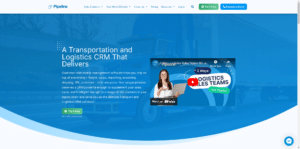Construction sales forecasting can be challenging because construction projects can be unpredictable. The dynamic nature of the projects, moving parts, and material prices demand you to be flexible and cautious. If you aren’t careful, you may jeopardize your construction business. One smart way to avoid this is by conducting an accurate construction sales forecast.
Sales forecasting often involves large data sets and can be time-consuming. Even the smallest mistakes in calculation can result in inaccurate results, damaging your business.
If you plan to forecast your construction sales business, follow this guide to ensure you cover every part of it and calculate the numbers correctly.
Why Is Sales Forecasting Important for Construction Companies?
Before we get into the construction forecasting strategies, you need to understand why it’s necessary to make sales construction forecasting.
You may ask, “Isn’t dealing with construction projects as they come much easier?”
It may be easier, but won’t help your construction business stay sustainable, especially during tough times. As you know, the revenue of a construction business depends on the projects it has in the pipeline. When there is no ongoing project, you’ll likely have zero income. Indirectly, this influences how you manage your workforce, equipment, project timeline, buying and stocking materials, and more.
To keep your construction business afloat and profitable, you must know what can come in the future. This is why construction sales forecasting is essential. It helps you predict and prepare for unwanted surprises.
Below are five reasons why forecasting a construction lead pipeline is as necessary as delivering the perfect construction job.
A. Proper Budgeting
Sales forecasting gives construction companies a clearer view of future demands and potential revenue growth. The right projections enable your finance team to lay down income flows and profit plans. This lets them estimate business costs, set up precise annual budgets, and help calculate the ideal profits. You can also ensure you have everything you need (e.g., the number of active leads) to hit the projected growth.
B. Accurate Resource Allocation
Struggling with resource allocation is a common challenge in the construction industry. However, when you know about the upcoming projects in your construction lead pipeline will let you distribute resources accurately.
You will have enough time to adjust your workforce, check equipment availability, and source materials to meet project demands. Effective resource allocation ensures you don’t lose out on potential leads or projects, reduces wastage, and optimizes labor efficiency.
C. Strategic Planning
You can’t expect to adapt to the rapidly changing market needs with traditional planning (e.g., annual or quarterly planning). A construction company’s strategies must be agile to sustain in competitive markets – and sales forecasting plays a key part here.
By calculating the projections for the construction lead pipeline, you can identify future demand for construction goods and services and arrange them early. It also enables a strategic approach to ongoing and upcoming trends in the construction market before your competitors do.
Moreover, sales forecasting lets you evaluate market size and new opportunities. You can lay down effective action plans, set realistic sales targets, and reach out to key customer segments with personalized campaigns and services.
Related: Learn the best practices for managing leads for construction projects in this blog.
You can also manage your material inventory better, including stocking items you need to hit the projected targets. This will minimize unnecessary buying and increase profits.
Sales forecasting also adds more depth to your competitor benchmarking, shows where you are lacking, and lets you make strategic improvements to your existing sales and marketing framework.
D. Better Risk Management
Accurate sales forecasting lets you anticipate probable risks and roadblocks in your construction lead pipeline. For example, if the forecast shows a downturn in sales in the coming months, you can take active measures to amp up your efforts to prevent that.
You can cut costs or invest in areas that need improvement, tweak the terms in your standard contract, and even provide additional offers to keep your sales numbers high. By detecting the warning signals early on, you can correct your strategies and mitigate the risks before it’s too late.
E. Revenue Growth
Proper construction forecasting helps you understand how much your products and services contribute to your bottom line or how long your sales team takes to close deals. Such insights let you pinpoint bottlenecks in your construction lead pipeline and take proactive measures to improve them.
You can plan raw material sourcing, strengthen your workforce to align with expected sales and roll out campaigns to maximize lead generation. Such efforts remove blockers and enhance operational efficiency.
Accurate sales forecasts also ensure your construction services are available when customers need them, preventing delays or stockouts. It improves customer satisfaction, generates word-of-mouth, and contributes to your revenue growth.
How to Generate Accurate Construction Sales Forecasting
We have learned how construction companies can benefit from accurate sales forecasting. However, only 45% of sales professionals are confident in their organization’s forecasting accuracy. This leaves much room for assumption rather than data-driven actions, which can result in unwanted consequences.
So, what can you do to ensure precision in forecasting your construction lead pipeline? Here’s your answer.
1. Gather Historical Data
To set up a standardized construction forecasting system, you must know your past sales performance inside and out. That way, you can understand the recurring patterns in your construction lead pipeline and create a strong foundation for your sales forecasting.
To accomplish this, first, you need to figure out which sales cycle you want to assess. This can be monthly, quarterly, or yearly. Then, combine your historical sales data and break them down according to the sales rep, service, price, and other relevant variables.
Next, examine your past leads and see which customer segments generated the most revenue for your business. Focus on seasonality and demand surges in those periods. Consider service cancellations and refunds. Then, build a sales run rate based on your findings.
The formula to calculate conversion rates, average sales cycle, and other metrics can be found in this sales metrics calculation blog.
2. Invest in a Construction CRM Software
As your construction business grows, so does your data. This isn’t ideal if you want to aim for accurate sales forecasting.
Avoid this by implementing a reliable sales CRM for construction. It will keep all your historical data organized in a single repository and let you filter them based on a particular period.
Moreover, other roles of CRM, namely lead management, will give you an accurate view of the construction lead pipeline and the deal status across the board. It will catch even the minuscule changes in your sales patterns and generate accurate forecasts within minutes.
While you may find many sales tools with forecasting features in the market, very few offer custom-made CRM for construction, like Pipeline CRM.
With Pipeline’s construction CRM, you can centralize all your sales data, get real-time sales performance insights, and generate accurate sales forecasting with just a few clicks.
3. Conduct Market Analysis
Map a detailed outline of the construction industry’s current state to identify trends and demands. Assess the direction the sector is heading, its size, and projected growth. Consider factors like the current economic climate and changes in government policies. Investigate the competition in your industry.
This way, you can accurately calculate how many and what kind of construction projects you can attract in the upcoming sales cycle.
4. Analyze Data
Identify the key variables that can potentially impact your construction sales. These may include population growth, construction permits, interest rates, and industry trends. Additionally, clean your data to ensure accuracy. Track any possible missing values, remove outliers, and standardize data formats.
Related: Learn why having clean data improves your sales performance and how to achieve it.
Choose a forecasting method based on your data variable and business goals. For instance, opportunity stage forecasting is best for relatively new construction ventures. However, for more detailed forecasting, multivariable analysis forecasting is an excellent method.
5. Align Sales and Marketing
Your marketing team has a direct view of the quality of your sales pipeline, while your sales team is at the forefront of handling and nurturing these leads. Therefore, aligning your sales and marketing efforts is important to get a clear and precise view of upcoming sales projections. Only then will you generate a holistic construction sales forecast.
To do this, ensure your marketing and sales staff can access all the related data. Sit down with them to understand their action plans. This will close any possible gaps in your forecast and keep all the stakeholders on the same page.
Using a construction sales CRM will give your teams immediate access to all relevant data and previous forecasts. It will ensure their views on the sales forecasts are synced to avoid miscommunication.
6. Consider the “What Ifs” for better construction sales forecasting
Consider the common roadblocks in the construction industry to ensure precision in your sales forecasting.
What if you end up firing a few of your salespeople? How long would it take you to fill the vacancy? What if there is a sudden economic crisis? Include these factors in your forecasting process for the most accurate and safe projections.
Get an Accurate Sales Forecast with Construction CRM Software
Sales forecasting allows you to predict your construction business’s best and worst. To get accurate sales construction forecasting, you need the right method and the help of construction CRM software.
Pipeline’s CRM for construction provides the features you need to generate reliable sales forecasts. For instance, our reporting feature lets you track every customer interaction, essential documents (e.g., building permits, contractor reports, contracts), project estimates, and more—all in one place.
You can monitor every stage of the sales process and assess the health of your construction lead pipeline. And the best part? You get a detailed view of past trends, market changes, and your previous sales records for reliable construction forecasting.
Want to stay ahead of your competition with spot-on sales projections? Adopt Pipeline CRM today and start with a 14-day free trial!
Recommended Reading:




